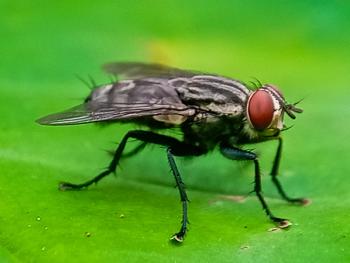
Tick-borne diseases: Ehrlichiosis and Rocky Mountain spotted fever (Proceedings)
Vector-borne diseases in general, and tick-borne diseases in particular, are increasingly recognized as important in both veterinary medicine and public health. In recent years, new disease agents have been identified in both dogs and people, tick populations have increased in number and extent of geographic distribution, and the potential for transmission of disease agents to people and dogs appears to be increasing.
Vector-borne diseases in general, and tick-borne diseases in particular, are increasingly recognized as important in both veterinary medicine and public health. In recent years, new disease agents have been identified in both dogs and people, tick populations have increased in number and extent of geographic distribution, and the potential for transmission of disease agents to people and dogs appears to be increasing. Throughout much of the United States, as many as six major tick species may be commonly found on dogs, and at least one stage or species of tick is active in any given month, creating a risk for year-round transmission of a number of different tick-borne disease agents (Table 1). This presentation will review important features of two common tick-borne diseases of dogs, ehrlichiosis and Rocky Mountain spotted fever, including clinical features, diagnostic and treatment strategies, where the infections occur geographically, and frequency and importance of infection and co-infection with these agents.
Interpreting test results for agents of ehrlichiosis and RMSF
Tick-borne disease testing often involves detection of antibodies to different organisms of interest. Antibodies may be detected on a patient-side assay such as the 3Dx/4Dx SNAP tests (ehrlichosis) or may require a diagnostic laboratory to perform an IFA (RMSF). The E. canis component of the 3Dx/4Dx assay indicates that antibodies are present, and thus prior or current infection, but not necessarily disease, has occurred. Thus, when positives occur, a complete blood count with platelet count should be performed. If a low platelet count is present then treatment is indicated. Treatment is also indicated in any clinically ill dog. A positive also may be generated on the E. canis spot when exposure to E. chaffeensis has occurred; indeed, recent research shows that the majority of E. canis SNAP-positive dogs in some areas actually have exposure to E. chaffeensis. Antibodies may also be detected on IFA using E. canis infected cells as antigen. This approach allows determination of a titer. However, cross-reactivity among different Ehrlichia spp., including E. canis, E. chaffeensis, and E. ewingii is common. Regardless of the cause of antibody production, positives do indicate that there has been a breach in the tick control program and that the dog is being bitten by ticks and at risk of contracting a tick-borne disease. For detecting antibodies to RMSF, IFA using R. rickettsii infected cells as antigen is performed. Rapid patient-side assays for RMSF are not available. The IFA also detects antibodies generated against other Rickettsia spp. and so specificity for R. rickettsii is not assured. Dogs with RMSF can develop severe disease and die prior to seroconversion; treatment should not be delayed pending confirmation with serologic testing.
Other tests for ehrlichiosis and RMSF include polymerase chain reaction, examination of stained blood smears, and culture. Testing by PCR, which detects DNA of causative agents, can be quite useful to diagnose acute ehrlichiosis or RMSF, so long as circulating organisms are present. Ehrlichia spp. are found in circulating monocytes (E. canis, E. chaffeensis) or neutrophils (E. ewingii). Rickettsia rickettsii may be present in circulation and thus detected by PCR in sloughed infected endothelial cells. Ehrlichiosis can also be diagnosed by finding organisms within blood cells on stained blood smears. However, the organisms are often present in low numbers, particularly with the monocytic forms, and specialized training is required to identify them accurately. A negative result on PCR or blood smear examination does not rule-out the possibility of infection. Culture for Ehrlichia spp. can be performed but is challenging and largely reserved for specialized research laboratories. Culture of R. rickettsii is only performed in high level biosafety laboratories (BL-3) due to the risk of severe human disease.
Geographic distribution of ehrlichiosis and RMSF
Ehrlichiosis
In the US, canine ehrlichiosis is most frequently caused by Ehrlichia canis, E. ewingii, and E. chaffeensis. All three agents are most common in the southern US, with E. ewingii and E. chaffeensis particularly common in the southcentral states. Of the three, E. canis is the best known and causes both an acute and a recrudescing chronic febrile disease in infected dogs; the organism is transmitted from infected to naïve dogs via Rhipicephalus sanguineus ticks, although Dermacentor variabilis may also serve as a vector for E. canis. Ehrlichia ewingii is a granulocytic ehrlichiosis agent which, in recent years, has been found to be more common in dogs than E. canis in some surveys, a predominance that is likely explained by the high exposure rates of dogs to the vector lone star ticks in many areas. Human cases of ehrlichosis are largely limited to the hyperendemic areas in the southeastern and southcentral US where Amblyomma americanum ticks are frequently encountered. While dogs serve as reservoir for both E. canis and E. ewingii, white-tailed deer are considered the primary reservoir host for E. chaffeensis.
Rocky Mountain spotted fever
Rocky Mountain spotted fever, most often transmitted by Dermacentor ticks, is reported throughout the continental US, sparing only the most northeastern states (VT and ME). In people, RMSF is most commonly reported in young (5-9 years) rural males and in older adults (40-64 years). Despite being names for a western mountain range where it was first identified, RMSF is most commonly reported from southcentral and mid-Atlantic states, and the great majority of cases are reported from just five middle-South states: Oklahoma, Arkansas, Tennessee, North Carolina, and South Carolina. A novel focus of infection was identified in the southwestern US and is transmitted to dogs and people via R. sanguineus rather than Dermacentor spp. Because R. rickettsii is somewhat discontinuously distributed in ticks, dogs can serve as valuable sentinels of infection. Indeed, several case reports link recognition of RMSF in dogs with identification of infection in people in the same area.
Clinical disease
Ehrlichiosis
Of the ehrlichial agents that infect dogs, Ehrlichia canis causes the most severe disease. Infections result in fever, myalgia, depression, leucopenia, and thrombocytopenia which may lead to bleeding diatheses, particularly epistaxis. Infection with E. ewingii and E. chaffeens is generally results in mild to moderate febrile disease in dogs. Although not always present, polyarthritis is particularly associated with E. ewingii infections in dogs, and disease with any of the ehrlichial pathogens may be more severe when co-infections occur. Nonetheless, many infected dogs are asymptomatic. As molecular testing becomes readily available and more widely applied, additional ehrlichial pathogens of people and dogs will likely be identified.
RMSF
Infection with R. rickettsii induces an extremely severe, potentially fatal disease in both people and dogs. Indeed, among the tick-borne diseases in North America, RMSF is the most severe and may result in acute disease characterized by rapid progression and high fatality. Mortality rates have been estimated at 20% in people in the absence of appropriate antibiotic treatment and 5% in patients who receive antibiotics; mortality rates are not established in natural infections of dogs but are considered high, particularly if appropriate treatment is not instituted. Affected dogs present with fever, lethargy, vomiting, and anorexia. As infection progresses additional signs may develop including bleeding diatheses, arthritis, ocular pathology, and neurologic disease.
Treatment and prevention of ehrlichiosis and RMSF
Both ehrlichiosis and RMSF can be effectively treated with a 4-week course of doxycycline; repeated or extended treatment may be necessary in some refractory cases. Vaccines are not available to protect dogs or people from infection with either of these tick-borne disease agents. Thus, preventing infection in both pets and people relies almost entirely on careful adherence to tick control measures.
The most common source of ticks to both people and pets is contact with recently emerged or questing stages in an infested environment rather than direct contact with infested dogs. Keeping pets on effective acaricides year-round likely decreases the population of ticks within the pets' home range, and thus decreases the overall number of ticks to which both pets and people are exposed. Following tick protective measures, such as performing frequent tick checks and promptly removing any attached ticks when in a tick-infested environment, further safeguards both human and pet health. With strict adherence to the routine use of tick control products on pets, and care whenever entering a potentially tick-infested environment, the risk of infection with tick-borne disease agents in both pets and people can be reduced.
References
Allen KE, Li Y, Kaltenboeck B, Johnson EM, Reichard MV, Panciera RJ, Little SE. 2008. Diversity of Hepatozoon species in naturally infected dogs in the southern United States. Vet Parasitol. 154:220-5.
Bowman DD, Little SE, Lorentzen L, et al. 2009. Prevalence and geographic distribution of Dirofilaria immitis, Borrelia burgdorferi, Ehrlichia canis, and Anaplasma phagocytophilum in dogs in the United States: results of a national clinic-based serologic survey. Vet Parasitol. 160:138-48.
Companion Animal Parasite Council Guidelines, Vector-borne Diseases.
Demma, L.J. et al. 2005. Rocky Mountain spotted fever from an unexpected tick vector in Arizona. N. Engl. J. Med. 353, 587-594
Kidd, L. et al. 2008. Evaluation of conventional and real-time PCR assays for detection and differentiation of Spotted Fever Group Rickettsia in dog blood. Vet. Microbiol. 129, 294-303
Liddell AM, Stockham SL, Scott MA, et al. 2003. Predominance of Ehrlichia ewingii in Missouri dogs. J Clin Microbiol. 41(10):4617-22.
Marshall GS, Jacobs RF, Schutze GE, et al. 2002. Ehrlichia chaffeensis seroprevalence among children in the southeast and south-central regions of the United States. Arch Pediatr Adolesc Med 156(2):166-70.
Paddock, C.D. et al. 2002. Short report: concurrent Rocky Mountain spotted fever in a dog and its owner. Am. J. Trop. Med. Hyg. 66, 197-199.
Seaman RL, Kania SA, Hegarty BC, et al. 2004. Comparison of results for serologic testing and a polymerase chain reaction assay to determine the prevalence of stray dogs in eastern Tennessee seropositive to Ehrlichia canis. Am J Vet Res 65(9):1200-3.
Warner, R.D. and Marsh, W.W. 2002. Rocky Mountain spotted fever. J. Am. Vet. Med. Assoc. 221, 1413-1417.
Yabsley MJ, Wimberly MC, Stallknecht DE, et al. 2005. Spatial analysis of the distribution of Ehrlichia chaffeensis, causative agent of human monocytotropic ehrlichiosis, across a multi-state region. Am J Trop Med Hyg 72, 840-50.
Newsletter
From exam room tips to practice management insights, get trusted veterinary news delivered straight to your inbox—subscribe to dvm360.




